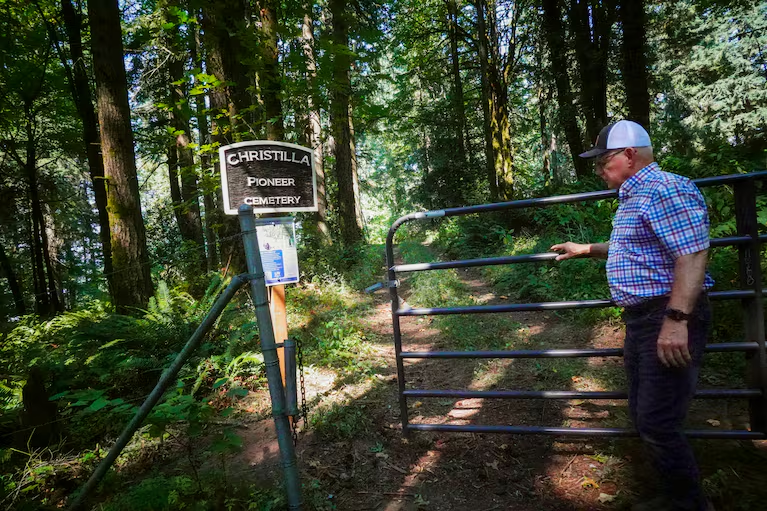A Hidden Landmark in Happy Valley
On Scouters’ Mountain in Happy Valley, where scenic trails wind through forests and offer breathtaking views of Mt. Hood, lies a quiet site that has remained hidden for generations. Behind a chain-link fence and tucked away from suburban development is the Christilla Pioneer Cemetery—a burial ground established in 1852 that has been closed to the public for nearly a century.
Now, after 173 years, the cemetery is finally being made accessible to the broader community. The move is part of an effort to preserve its history and ensure the sacrifices of Happy Valley’s earliest settlers are not forgotten.
Roots of the Cemetery
The Christilla Pioneer Cemetery began with Christian and Matilda Deardorff, who arrived in Oregon by covered wagon from Iowa in 1850. Their graves form the heart of the cemetery. The first person buried there, however, was an unidentified pioneer, remembered only as the “Covered Wagon Pioneer.”
Also Read
For decades, the site remained a family-held property. The last recorded burial was in 1988, an infant whose grave marked the end of the cemetery’s use. By then, it had already been closed to the public for more than 50 years.
A Family Legacy
For the Deardorff family, the cemetery has been both a sacred responsibility and a personal heirloom. Dennis Deardorff, a retired pastor and descendant of Christian and Matilda, has taken on the role of caretaker.
“You can see how tranquil it is here — this really is serene,” Deardorff said. “Other than the stones deteriorating, this place hasn’t changed much.”
In past decades, the Deardorff family would gather annually for reunions, combining picnics with cemetery clean-up days. Dennis recalls childhood memories of exploring the surrounding woods, not realizing then how deeply the responsibility of preserving the site would one day fall on his shoulders.
Struggles with Time and Neglect
As family interest waned, the cemetery began to slip into disrepair. Headstones became overgrown, and some markers were vandalized or stolen. The once-proud family site risked fading into obscurity.
Concerned, Deardorff reached out to the City of Happy Valley and local organizations for help. His efforts led to a new partnership dedicated to both restoring the cemetery and opening it to the public.
Community Steps In
Recently, volunteers from the Rotary Club, Boys Team Charity, National Charity League, and Happy Valley Hikers joined together for a massive clean-up. Overgrowth was cleared, gravestones were uncovered, and the site regained its dignity.
Steve Campbell, Happy Valley’s director of community services, said the city will support trail development and increased protections against vandalism. “Residents care a great deal about history,” Campbell said. “This cemetery is a reminder of the sacrifices made by families who traveled the Oregon Trail to settle here.”
Plans for an Interpretive Trail
The city and community partners envision turning the five acres surrounding the cemetery into an interpretive history trail. The project, expected to take about a year, would feature multiple stops sharing stories of the pioneers who shaped early Happy Valley.
At the same time, efforts are underway to identify the unmarked graves scattered across the grounds. Currently, 29 graves are confirmed, but many early burials were marked with wood, which has long since deteriorated. Deardorff is pursuing a grant to use ground-penetrating radar to map the resting places of forgotten pioneers.
Renewed Interest in Local Roots
Despite the challenges, Deardorff said he is encouraged by the strong turnout of volunteers and the renewed public interest in the cemetery’s history.
“Even though people aren’t related, there’s an affiliation,” he said. “It’s exciting to see a new generation saying, ‘My roots are important.’”
With its gates now open and new projects underway, the Christilla Pioneer Cemetery is emerging from obscurity. What was once a private family burial ground is becoming a shared piece of community heritage—a tranquil site that honors Oregon’s past while inspiring future generations to remember their roots.












